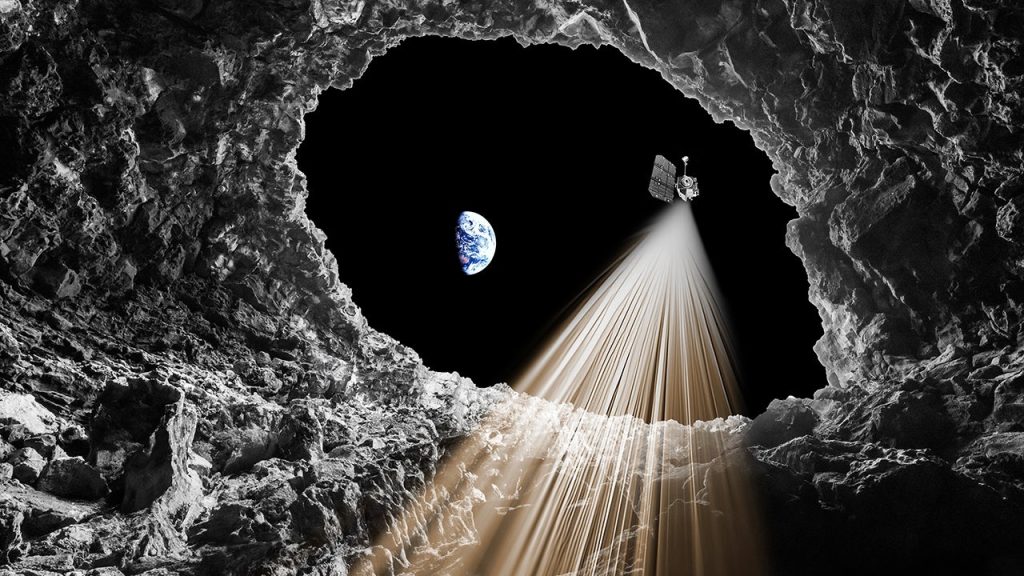An international team of scientists has confirmed for the first time the existence of a massive underground tunnel beneath the surface of the moon that could one day help astronauts protect themselves from the extreme temperatures and radiation that befall the lunar surface.
Since 2009, more than 200 shadowy holes have been discovered on the surface of the moon. Many of these holes may have been formed by volcanic activity, and it has been suspected for decades that some are underground holes formed by lava flows long ago. Now, a new Natural Astronomy A study has revealed exactly what lies beyond the entrance to one such hole in the Mare Tranquillitatis region of the moon.
The central data in the paper was collected by a small radio frequency (mini-RF) device on NASA’s Lunar Reconnaissance Orbiter, a lunar probe that passed a few dozen kilometers above Earth’s largest natural satellite in 2010. The mini-RF device is a type of synthetic aperture radar that works by emitting electromagnetic waves to the lunar surface and listening to the radar “echoes” that bounce back toward the spacecraft.
Using cutting-edge signal processing techniques, researchers led by scientists from the University of Trento in Italy were able to decipher the LRO data and determine the nature of the cavern that lies beneath the shadowy Mare Tranquillitatis opening.
“Thanks to the analysis of the data, we were able to create a model of part of the conduit,” University of Trent “The most likely explanation for our observations is an empty lava tube,” said the co-author of the new paper.
For decades, scientists have thought that the moon’s holes might contain vast cave systems carved out by lava long ago, but new research has revealed that Natural Astronomy This study is the first to demonstrate the existence of such a tunnel using radar data.
The data revealed an underground cavern stretching for tens of metres, suggesting the possibility of a much larger hidden area beyond. The study authors believe that the Mare Tranquility cave and others like it could be promising sites for future lunar habitats, which would use the lunar soil (regolith) as natural protection from solar radiation and extreme surface temperatures.
There are accessible cave passages beneath the surface of the moon. Carrer et al.: https://t.co/HnW6g5AjDs pic.twitter.com/bOAi9htsGg
— Nature Astronomy (@NatureAstronomy) July 15, 2024
According to NASA, the temperature on the sunlit side of the moon can reach 260 °F (127 °C), while the shaded side can cool to -280 °F (-173 °C). However, the temperature in the lunar cavity is estimated to be a more comfortable 63 °F (17 °C), and is thought to vary less.
Camping underground would also provide a natural defense against the ever-present threat of micrometeorite impacts, and protect the astronauts from radiation from the sun and beyond – some 150 times more powerful than what we experience on Earth.
Of course, trying to build a habitat in a hole on the moon would create its own myriad of problems that would have to be addressed by inventing bold new technologies. NASA’s next crewed space mission is scheduled for September 2025.The astronauts would then orbit the moon and return to Earth’s atmosphere aboard NASA’s Orion spacecraft. But the historic Artemis 3 mission, planned to put US astronauts back on the lunar surface, where NASA hopes to establish a permanent base before setting off on its journey to Mars, isn’t likely to happen until September 2026 at the earliest.
Image credit: Credit: Photo manipulation by A. Romeo. LRO 3D model by NASA (Brian Kumanchik, Christian Lopez, NASA/JPL-Caltech). The Earthrise photograph was taken by Apollo 8 astronaut Bill Anders on December 24, 1968 at 16:40 UTC.
Anthony is a freelance contributor covering science and video game news for IGN. He’s been writing about the latest developments in multiple scientific fields for over 8 years and has zero time for your shenanigans. Follow him on Twitter @BeardConGamer.


